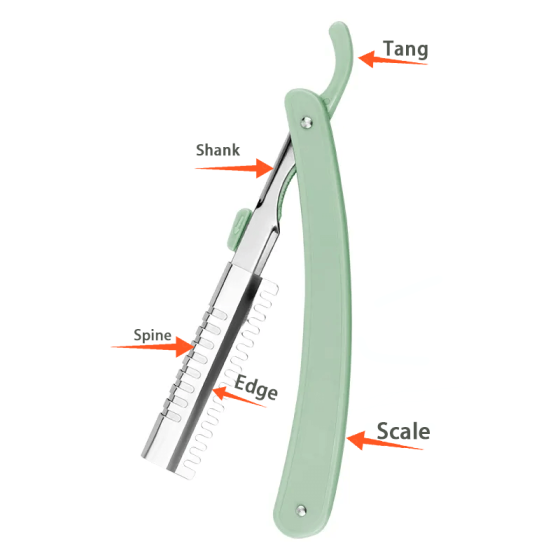विषय-सूची
- Introduction to Straight Razor Parts
- Preparing the Razor
- Face Preparation
- Holding and Using the Razor
- Post-Shave Care
- Benefits and Challenges of Straight Razor Shaving
1. Introduction to Straight Razor Parts

Knowing the parts of a straight razor is key to using and maintaining it effectively. Here’s a breakdown of its components:
- Tang: The blade’s extension into the handle, used for gripping during stropping or honing.
- Shank: The slim section between the tang and shoulder, providing a hold for control.
- Shoulder: The wider part where the shank meets the blade, adding stability.
- Spine: The thick, non-sharpened top edge of the blade, balancing its structure.
- Heel: The blade section nearest the handle, ideal for precision shaving.
- Edge: The sharp cutting side that does the shaving.
- Point: The blade’s tip, perfect for detailed work.
- Toe: The blade’s far end, opposite the heel, often the starting point for strokes.
- Scale: The folding handle, typically two pieces, protecting the blade when stored.
Understanding these parts enhances your ability to wield the razor with confidence.
2.Straight razor installation steps

3. Preparing the Razor
To achieve a smooth shave, the straight razor must be prepped with stropping, a process that aligns the blade’s edge. This differs from honing, which sharpens the blade using a wet stone and is done less frequently.
Stropping Steps:
- औजार: Use a strop, usually made of premium leather, though other materials work too.
- Setup: Attach one end of the strop to a fixed object (e.g., a bedpost) and pull the other end tight with your non-dominant hand.
Process:
- Lay the razor flat on the strop, edge facing you.
- Slide the blade gently upward along the leather.
- Flip the razor so the edge still faces you, then slide it downward.
- Repeat 40–60 times for a well-aligned edge.
Key Difference: Stropping maintains the edge before each shave, while honing, done every few months, restores sharpness.
4. Face Preparation
Prepping your face is vital for a comfortable shave, softening the hair and opening pores to ease cutting.
Steps:
Warm Water: Apply warm or hot water via:
- A shower or bath.
- A hot towel wrapped around your face for a few minutes.
Lathering:
- Massage shaving cream or soap into your beard or stubble with your fingers or a brush.
- Keep the lather wet to ensure the razor glides easily.
- This preparation minimizes irritation and sets the stage for a clean shave.
5. Holding and Using the Razor
Proper grip and technique are crucial for a safe and effective shave with a straight razor.
Grip:
- Hold the razor in your dominant hand.
- Place your thumb under the shank, near the shoulder.
- Rest your index, middle, and ring fingers on top of the shank.
- Tuck the tang between your ring finger and pinky, with your pinky resting on its crescent curve (adjust fingers as feels natural).
Shaving Steps:
- Stretch the Skin: Use your free hand to pull the skin taut.
- Angle the Blade: Keep a 30-degree angle between the blade and skin. Start by laying it flat on your cheek, then lift the spine slightly.
- First Pass: Shave with the grain (hair growth direction) using light, steady strokes.
- Second Pass (Optional): Rinse, re-lather, and shave against the grain for a closer result.
- Rinse: Wash with warm water, then cold to close pores.
- Handle Cuts: Apply an alum block or styptic pencil if you nick yourself.
Practice short strokes at first, building up to longer ones as you gain skill.
6. Post-Shave Care
Aftercare keeps your skin and razor in top shape.
Skin Care:
- Rinse with cold water to close pores.
- Use an aftershave balm or lotion to soothe and moisturize.
Razor Care:
- Rinse the razor under running water to clear hair and lather.
- Dry it carefully with a cloth or towel.
- Store it in a dry spot to avoid rust.
Consistent care prolongs the razor’s life and performance.
7. Benefits and Challenges of Straight Razor Shaving
Straight razor shaving offers unique rewards but comes with a learning curve.
Benefits:
- Economical: No recurring blade costs, just upkeep.
- Control: The larger blade allows precise navigation of facial contours.
- Smoothness: Often delivers a closer, cleaner shave.
- Tradition: Turns shaving into a satisfying ritual.
Challenges:
- Skill: Requires time to master safely.
- Upkeep: Needs regular stropping and occasional honing.
- Time: Takes longer than modern razors.
With dedication, the benefits outweigh the effort for many enthusiasts.
 Xiruiglobal.COM
Xiruiglobal.COM


